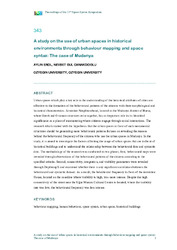A study on the use of urban spaces in historical environments through behaviour mapping and space syntax: The case of Mudanya
| dc.contributor.author | Erol, Aylin | |
| dc.contributor.author | Çanakçıoğlu, Nevşet Gül | |
| dc.date.accessioned | 2023-08-07T08:25:40Z | |
| dc.date.available | 2023-08-07T08:25:40Z | |
| dc.date.issued | 2022 | |
| dc.identifier.isbn | 978-829367767-3 | |
| dc.identifier.uri | http://hdl.handle.net/10679/8575 | |
| dc.identifier.uri | https://www.hvl.no/globalassets/hvl-internett/arrangement/2022/13sss/343erol.pdf | |
| dc.description.abstract | Urban spaces which play a key role in the understanding of the historical attributes of cities are effective in the formation of the behavioural patterns of the citizens with their morphological and historical characteristics. Armistice Neighbourhood, located in the Mudanya district of Bursa, where Greek and Ottoman structures exist together, has an important role in its historical significance as a place of encountering where citizens engage through social interactions. The research which started with the hypothesis that the urban spaces in front of such monumental structures should be generating more behavioural patterns focuses on revealing the reasons behind the behavioural frequency of the citizens who use the urban spaces in Mudanya. In the study, it is aimed to investigate the factors affecting the usage of urban spaces that are in front of historical buildings and to understand the relationship between the behavioural data and syntactic data. The methodology of the research was conducted in two phases; first, behavioural maps were revealed through observations of the behavioural patterns of the citizens according to the specified criteria. Second, connectivity, integration, and visibility parameters were revealed through DepthmapX and examined whether there is any significant correlation between the behavioural and syntactic dataset. As a result, the behavioural frequency in front of the Armistice House, located on the coastline where visibility is high, was more intense. Despite the high connectivity of the street near the Uğur Mumcu Cultural Centre is located, where the visibility rate was low, the behavioural frequency was less intense. | en_US |
| dc.language.iso | eng | en_US |
| dc.publisher | Western Norway University of Applied Sciences (HVL) | en_US |
| dc.relation.ispartof | Proceedings 13th International Space Syntax Symposium, SSS 2022 | |
| dc.rights | openAccess | |
| dc.title | A study on the use of urban spaces in historical environments through behaviour mapping and space syntax: The case of Mudanya | en_US |
| dc.type | Conference paper | en_US |
| dc.publicationstatus | Published | en_US |
| dc.contributor.department | Özyeğin University | |
| dc.contributor.authorID | (ORCID 0000-0002-8289-3601 & YÖK ID 159795) Çanakçıoğlu, Gül | |
| dc.contributor.ozuauthor | Çanakçıoğlu, Nevşet Gül | |
| dc.subject.keywords | Behaviour mapping | en_US |
| dc.subject.keywords | Historical buildings | en_US |
| dc.subject.keywords | Human behaviour | en_US |
| dc.subject.keywords | Space syntax | en_US |
| dc.subject.keywords | Urban space | en_US |
| dc.identifier.scopus | SCOPUS:2-s2.0-85145579687 | |
| dc.contributor.ozugradstudent | Erol, Aylin | |
| dc.relation.publicationcategory | Conference Paper - International - Institutional Academic Staff and Graduate Student |
Files in this item
This item appears in the following Collection(s)
Share this page



